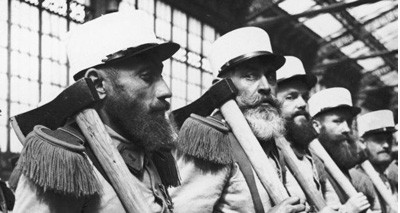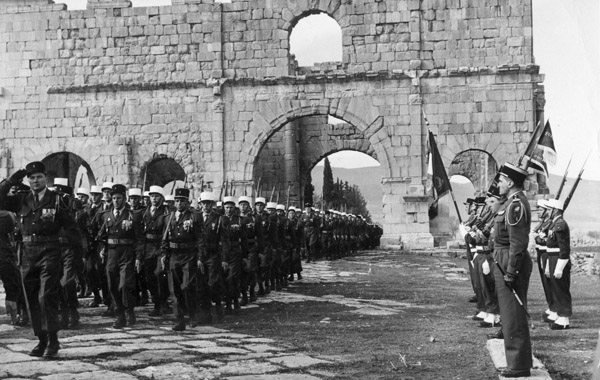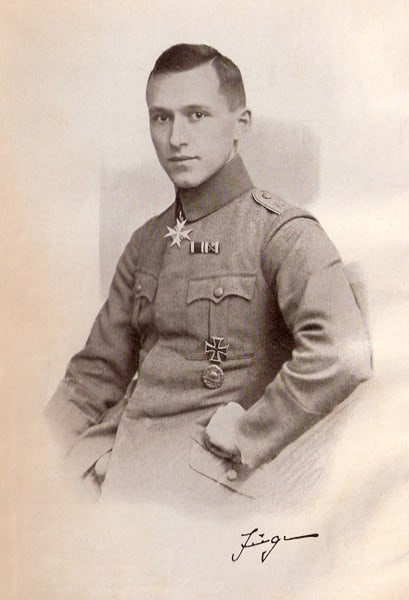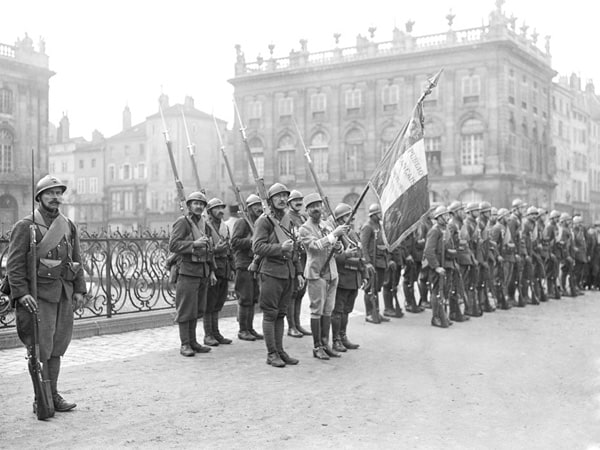White Hats, White Fighters
Sinclair Jenkins, American Renaissance, October 13, 2017

Jean-Vincent Blanchard, At The Edge of the World: The Heroic Century of the French Foreign Legion, Bloomsbury Press, 2017, $16.65, 262 pp.
The French Foreign Legion seems like a fighting force made for Hollywood. With its white hats (kepis blancs), sharp uniforms, and its reputation for enlisting men with no place left to go, the legion seems like the stuff of romance.

Jean-Vincent Blanchard, a French Studies professor at Swarthmore College, portrays the legion during what is widely considered its golden age — roughly from 1880 until 1939. In Professor Blanchard’s telling, the legion was neither a complete band of rogues, nor a fully modern military force. Yes, these men were professional soldiers, and many fled troubled lives in their native lands in order to seek money, pleasure, and danger in the legion. Many also joined to escape bourgeois culture and create a männerbund (a competitive, hierarchical group of men).
Some of the legion’s leading officers supported this anti-modernist attitude. General Hubert Lyautey comes close to being the central figure of Prof. Blanchard’s fascinating study. A native of Lorraine with noble ancestry who attended France’s Saint-Cyr military academy, Lyautey was a staunch Catholic, a conservative supporter of Action française, and a sworn enemy of the “decadent” Third Republic. He became the legion’s greatest leader during the age of France’s colonial expansion. Lyautey once summarized his personal politics as “incompatible with egalitarian and collectivist society.”
For Lyautey and other French generals who were drawn to the legion, it provided an “alternative to what seemed like an increasingly materialistic, disenchanted existence.” For these men, life — real life — was fighting Bedouin or Tuareg tribesmen in the desert of Morocco, or putting down Tonkin pirates. One of the legion’s most famous recruits, a German youth named Ernst Jünger, saw it as a chance to break away from the stifling boredom and conformity of a wealthy, peaceful Europe:
. . . those young persons who, in the foggy dark of night, left their parental home to pursue danger in America, on the sea, or in the French Foreign Legion. It is a sign of the domination of bourgeoisie values that danger slips into the distance.
The attraction for men like Jünger was the myth of the legion. It had became prized for its superior fighting skills, its ability to travel light, its maneuverability, and its reputation for fighting to the bitter end. No battle is more enshrined in legion legend quite like the siege of Camaron in 1863. On April 30th, Captain Jean Danjou and sixty-three legionnaires found themselves surrounded by a larger force of Mexican republicans. The legionnaires fought until only a few were left standing. Their Mexican opponents called them “demons” because of their fierceness.

Ernst Jünger
When men joined this elite force, however, romantic idealism was often the first casualty. After signing up for their first five-year enlistment and undergoing basic medical examinations, legionnaires received their first lodgings at Fort Saint-Jean in Marseilles. Described by Blanchard as “imposing and gloomy,” this fortress offered recruits their first taste of strict military life. From here, recruits were put on ships for the training camps in French Algeria.
For legionnaires, basic training including marching, rifle practice, physical training (including boxing), and more marching. The only perks of that period were the showers, the French bread, the meat stews, and liberal portions of Algerian wine. The legion ran on wine and strong coffee, the latter of which was ordered with shouts of “Au jus! Au jus!” When not marching, legionnaires peeled potatoes and cleaned their barracks. The legion prided itself on neatness and order, which is a far cry for its daredevil reputation.
Besides idealists who got their first taste of the strenuous life, the legion often attracted Europe’s criminals, but Prof. Blanchard is quick to note that the idea that the legion accepted murderers is mostly based on German propaganda from before the outbreak of the First World War. The Bat’ d’Af were the penal regiments made up of the French Army’s nastiest criminals, but because they often shared the North African deserts with the legion, many people confused the two. The legion did accept some petty criminals or those who had gotten into trouble with other armies, but rarely did they ever provide a new identity to a wanted murderer, rapist, etc.
The German government promoted the idea of a criminal legion because approximately two-thirds of legion’s soldiers were Germans or Austrians. A survey of the First Regiment of the French Foreign Legion found in 1897 that out of 7,066 soldiers, there were 1,612 Frenchmen, 1,551 men from German-controlled Alsace-Lorraine, and 1,441 Germans. France kept the German legionnaires busy fighting in the colonies rather than in the trenches of Europe during the Great War.
And there was a lot of fighting that needed to be done in the colonies between 1914 and 1918.
Prof. Blanchard describes in excellent detail how France’s conquest of Morocco lasted from 1912 up until the last Berber holdouts were shelled into submission in 1931. By that time, Lyautey, the face and mind of France’s “oil slick” concept of slow, hearts-and-minds colonization, was no longer leading the legion.

Besides his in-depth portrayal of the many campaigns of the legion — from the conquest of Tonkin to the horrors of counter-insurgency in Madagascar — Blanchard’s book is worth reading for its sociological study of the legionnaires themselves. They were hard-drinking men who usually spent their paydays visiting cafes and brothels. They were also exceptional builders whom Paris used as combat engineers. Foreign travelers often marveled at legion-built forts and villages, while legion deserters who fought with the Berbers in Morocco built stone huts that were far superior to those of the natives.
“To be a soldier in the Tonkin or in the Moroccan bled (countryside), no matter who you were, a private or a marshal, was to seek remediation toward a lost unity, even transcendence,” Prof. Blanchard writes. For Frenchmen, transcendence meant leaving behind the gross secularism and socialist politics Third Republic. For all legionnaires, it meant transcending petty nationalism in favor of recognizing a shared European identity. This supra-national identity was forged fighting non-whites, and like British soldiers fighting their own colonial wars, many legionnaires thought about race in terms that would horrify today’s Western youth. Legionnaires in Tonkin called their enemies “pirates” and “bandits,” and wrote in their diaries about how both Vietnamese and Chinese insurgents lived off “trafficking in weapons, opium, and women.”
In Indochina, legionnaires fought a murky insurgent war against an enemy that could easily blend in with the local peasant population. One veteran wrote about how the legion approached the problem of distinguishing between friend and foe:
We were allowed to kill and plunder everything when the villagers did not show up to submit. We left at night around ten or eleven, we went to villages and surprised the people in bed. We killed everything, men, women, children, at gun butt and with the bayonet, it was a real massacre.
As brutish as the war in Tonkin was, for legionnaires, service in East Asia was often seen as a reward. In Tonkin, Annam, and Cochinchina, legionnaires had access to attractive prostitutes, warm beaches, and the splendid sights of Buddhist pagodas ringed by green mountains. Legionnaires generally thought of the Vietnamese and southern Chinese as dirty and ignorant, but respected their ancient cultures.
North Africa was a different story. Although their French officers often celebrated the heroism of the Arab and Berber tribal fighters of Algeria and Morocco, the soldiers under them frequently saw French “pacification” in racial terms. Even during the nationalist antagonisms of the First World War, French and German legionnaires had no problem uniting to fight the hated Arabs. At this time the legion was only for white men, with native recruits put into their own formations such as the Zouaves and Skirmishers. Legionnaires came to identify the legion as something more important than their national origins, and all recruits were united by race.
Legion veterans also backed reactionary or nationalist causes. Jean-Marie Le Pen, who founded the National Front was a legionnaire. Imperialist diehards who participated in the Algiers Putsch of 1961 and the terrorist group OAS were all directly tied to the legion.
Today, although the legion’s doors have been opened to non-whites, a certain racial realism prevails. One unnamed officer told Vanity Fair journalist William Langewiesche that “the Chinese make the worst legionnaires,” while “Americans and British are almost as difficult, because they get upset about living conditions.” Ultimately, in today’s legion, the “French are flaky, the Serbs are tough, the Koreans are the best of the Asians, and the Brazilians are the best of all.”
Prof. Blanchard writes that legionnaires, for all their bluster and hard-boiled cynicism, were prone to le cafard — a type of nihilistic depression that often led to suicide. In the section on the conquest of Madagascar, Blanchard cites tales about legionnaires hanging or shooting themselves after battles or long marches. The dreary repetitiveness of slogging through the hot sun on little food or water caused many legionnaires to give up hope. Others decided that life as the sharp end of the French spear was not to their liking. When there was no battle, many legionnaires became apathetic and careless with their own lives.
Prof. Blanchard’s book is an excellent look at one of history’s most exciting military units during its heyday. However, it is marred by poor syntax and grammatical errors. It is hard to believe an editor even touched this volume.
The legion, which is a small, elite force in the French Army, has played an outsized role in modern French history. The United States has nothing like it.















